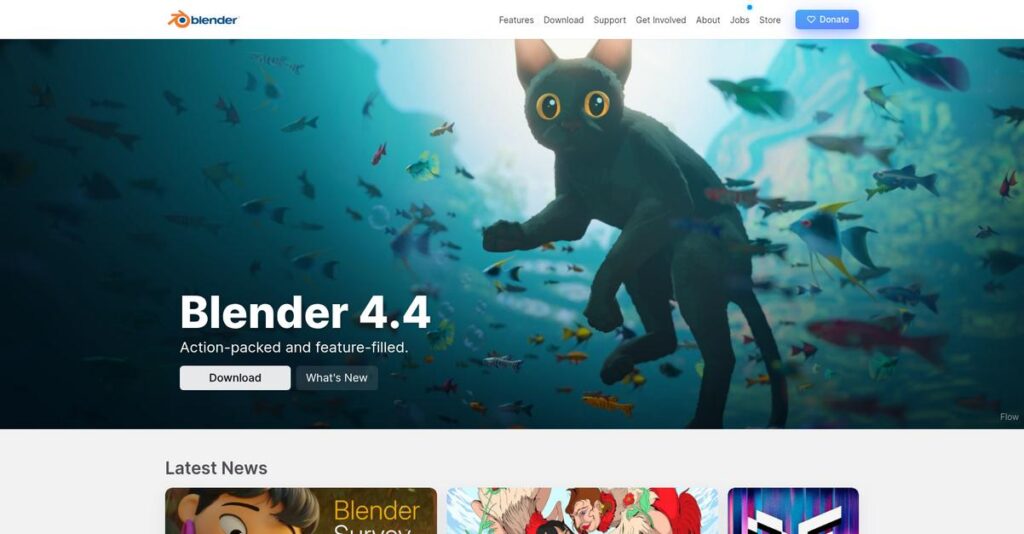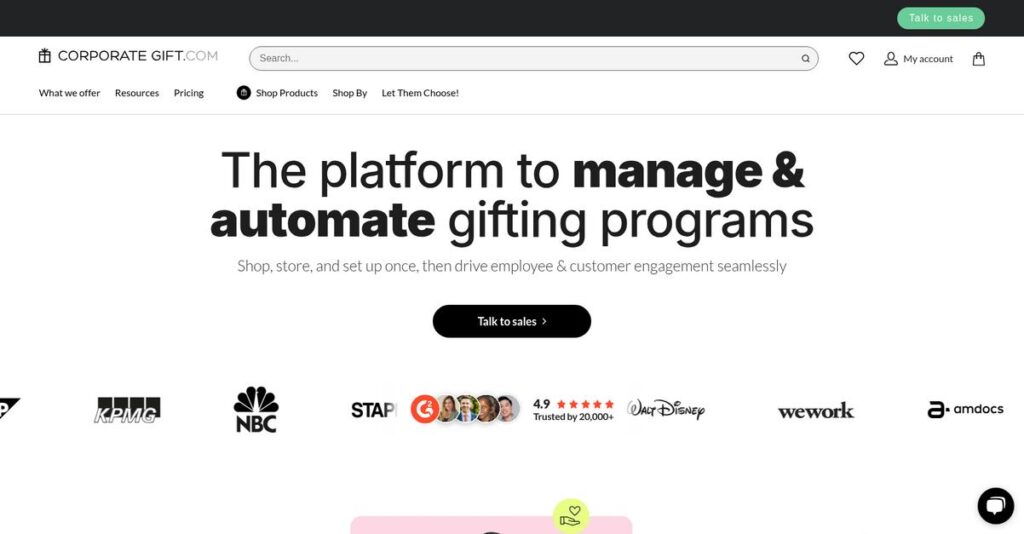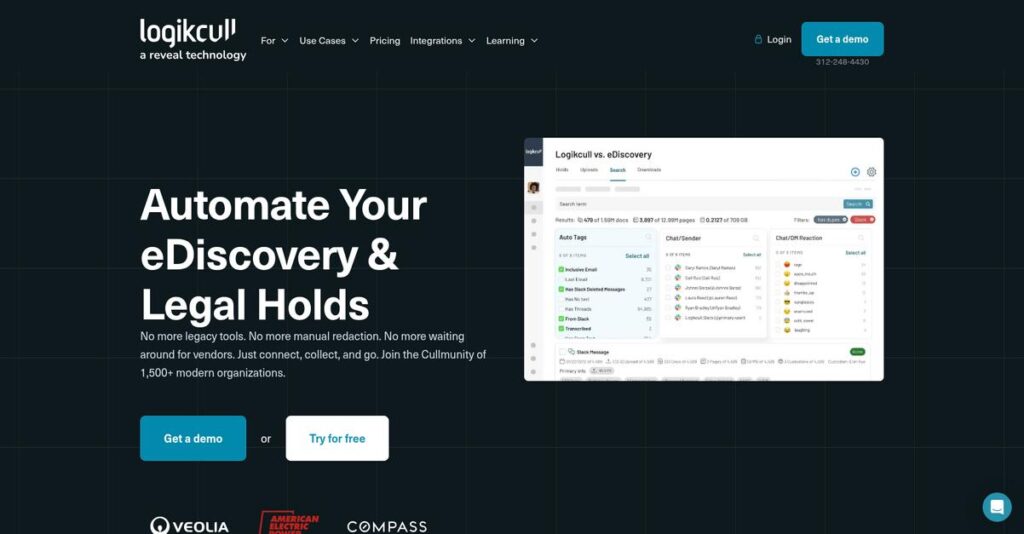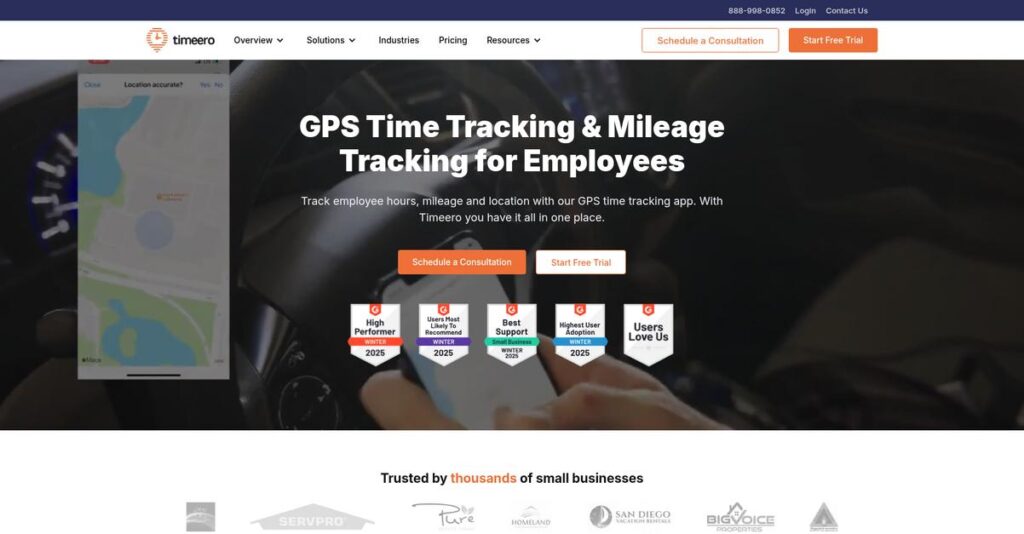All-in-one 3D creation shouldn’t be this hard.
If you’re considering Blender, you’re likely frustrated by expensive, fragmented 3D software where basic modeling, animation, or video workflows just don’t sync up.
What stings most is burning precious time jumping between tools, which slows every project, eats up creative energy, and makes collaboration feel impossible.
That’s why I’ve spent hours putting Blender through its paces—the free, open-source suite that combines modeling, sculpting, animation, rendering, video editing, and more in one unified pipeline. Unlike other solutions, Blender’s integrated approach means you aren’t constantly switching programs or worrying about costly add-ons. With advanced features like Geometry Nodes, Cycles/EEVEE rendering, and Grease Pencil for hybrid 2D/3D, Blender stands out for flexibility and pure creative speed.
Throughout this review, I’ll show you how Blender makes professional 3D work accessible for your projects, without the headaches or the price tag.
In this Blender review, you’ll find detailed analysis on features, performance, pricing, and how Blender compares to other leading 3D tools—so you can make a truly informed choice.
You’ll walk away knowing exactly the features you need to bring your creative vision to life—whether you’re modeling, animating, or editing video.
Let’s dive into the analysis.
Quick Summary
- Blender is a free, open-source 3D creation suite covering modeling, animation, rendering, and video editing in a single, unified toolset.
- Best for independent artists, small studios, and educators needing a versatile, cost-effective 3D solution.
- You’ll appreciate its comprehensive features and active community support that drive continuous improvements and learning resources.
- Blender offers a completely free license with no trial or fees, making professional-grade 3D accessible to all users.
Blender Overview
Headquartered in Amsterdam, the Blender Foundation has been on a mission since 1994: to provide the entire creative community with free and open access to 3D technology.
- 🎯 Bonus Resource: Speaking of specialized applications, if you’re exploring healthcare solutions, my guide on Best Dermatology Software covers essential tools.
Their platform is built for individual artists, indie developers, and small studios that can’t afford enterprise licenses. What truly sets them apart is their commitment to a unified 3D pipeline, which I find keeps your entire workflow from modeling to final render incredibly efficient.
Major grants from industry giants like Epic Games, Meta, and Nvidia constantly fuel its impressive innovation. You can see the direct results through this Blender review in its powerful new toolsets.
Unlike competitors like Maya or Cinema 4D that focus on specialized niches for a high price, Blender’s value is its comprehensive nature. It’s a complete professional creation suite that delivers immense power without ever costing you a subscription fee.
I’ve seen it used by a massive global community, from solo creators making their first short film to established VFX studios integrating it into their professional pipeline. This trust is why big names like Adobe and Google contribute.
From my perspective, their strategy is refreshingly community-driven, focusing on expanding procedural workflows and core performance based on user needs. This directly aligns with the market’s demand for a flexible, powerful tool that grows with your creative ambitions.
Let’s dive into its capabilities.
Blender Features
Is your 3D creation process a jumbled mess of separate tools?
Blender features provide an all-in-one solution for 3D creation, covering everything from modeling to video editing. Here are the five main Blender features that streamline your creative workflow.
1. 3D Modeling
Struggling to build intricate 3D models efficiently?
Traditional modeling can be time-consuming, especially when creating complex designs or needing iterative adjustments. This can slow down your project deadlines.
Blender’s extensive 3D modeling tools, including powerful Geometry Nodes, allow for procedural creation of complex structures. From my testing, being able to import various data formats like OBJ and PLY significantly speeds up integrating external assets. This feature means you can generate detailed architectural elements or organic shapes with remarkable flexibility.
This means you can build detailed 3D assets faster, ensuring your designs are both precise and adaptable.
2. Sculpting
Is digital sculpting feeling clunky and unresponsive?
Creating organic models with fine details often requires highly responsive tools that can handle high polygon counts without lag. Frustrating, right?
Blender’s sculpting capabilities offer over 20 brush types and dynamic topology, providing an intuitive, clay-like digital sculpting experience. Here’s what I found: the new brush asset shelf in Blender 4.3 makes managing your custom brushes incredibly efficient. This feature allows artists to meticulously refine characters or creatures with realistic muscle definition and skin folds.
So you can achieve highly detailed organic forms with ease, enhancing the realism of your characters and creatures.
3. Animation & Rigging
Tired of complex animation workflows for your characters?
Bringing 3D characters to life can be incredibly challenging, requiring precise control over movements and expressions. This often leads to stiff or unnatural animations.
Blender offers a robust animation system with a pose editor and non-linear animation, making character movement fluid. What I love about this feature is the unique Grease Pencil for 2D animation within a 3D environment, which allows for hybrid 2D/3D projects. This means you can easily synchronize sound and control animations with powerful constraints and drivers.
This means you can create dynamic and expressive animations, whether for animated shorts or interactive storytelling.
4. Rendering
Are your 3D renders lacking realism or taking forever to complete?
Achieving photorealistic visuals often demands powerful render engines that can accurately simulate light and materials without excessive wait times. This is a common bottleneck.
Blender includes three render engines: Cycles for physically accurate path tracing and EEVEE for real-time results. From my testing, Cycles’ expanded path guiding for glossy surfaces delivers incredibly realistic lighting and material interactions. This feature allows artists to achieve stunning visual fidelity with precise control over their scene’s illumination, enhancing the overall quality of their output.
So you can produce breathtakingly realistic renders, ensuring your visual presentations truly captivate your audience.
- 🎯 Bonus Resource: Before diving deeper, you might find my analysis of best medical store software helpful.
5. Video Editing & Compositing
Need to finalize your 3D project but hate switching to another software?
The post-production phase often requires external video editing and compositing tools, creating a disjointed workflow. This wastes valuable time.
Blender features a built-in non-linear video editor (VSE) and a node-based compositor for comprehensive post-production. This is where Blender shines: you can assemble, cut, and color-grade your rendered 3D scenes directly within the same application. This feature supports up to 32 slots for video, audio, and effects, making it incredibly versatile for final touches.
This means you can complete your entire 3D and video production pipeline in one place, saving time and simplifying your workflow.
Pros & Cons
- ✅ Comprehensive toolset covers entire 3D pipeline within one application.
- ✅ Free and open-source, offering professional-grade tools without cost.
- ✅ Active community and continuous updates provide robust support and new features.
- ⚠️ Steep learning curve can be challenging for beginners and new users.
- ⚠️ Performance for extremely high-polygon sculpting can be outmatched by specialized software.
- ⚠️ Motion graphics workflow can be less streamlined compared to dedicated alternatives.
You’ll appreciate how these Blender features work together as an integrated 3D creation ecosystem, allowing you to move seamlessly from concept to final output.
Blender Pricing
Worried about unexpected software costs?
Blender pricing stands out because it’s completely free and open-source, offering unparalleled accessibility without any licensing fees for your business.
| Plan | Price & Features |
|---|---|
| Core Software | Free & Open-Source • Full 3D pipeline (modeling, animation, rendering) • Unlimited commercial use • Regular updates and community support • No user limits or hidden fees |
| Third-Party Add-ons | Varies (Many Free Options) • Specialized tools and workflows • Enhanced productivity features • Community-developed extensions • Paid options for specific needs |
1. Value Assessment
Unbeatable value on offer.
From my cost analysis, Blender’s core software being free means your budget faces absolutely no licensing fees, whether you’re a freelancer or a studio. This eliminates the biggest financial barrier to entry for professional 3D tools, letting you allocate funds elsewhere.
This means your production costs stay remarkably low, giving you a significant competitive advantage.
2. Trial/Demo Options
Full access, no strings attached.
Blender offers the ultimate trial: permanent, full-featured access at no cost. You can download and explore every capability without time limits or restrictions. What I found invaluable is how this lets you evaluate the entire pipeline for your specific projects and workflows.
This lets you integrate and test Blender into your actual production environment before committing any resources.
- 🎯 Bonus Resource: While we’re discussing software tools, understanding the best radiology software is equally important.
3. Plan Comparison
Simplicity reigns supreme.
There are no confusing tiers with Blender; the core software is universally available without feature gates. This simplifies your decision-making process significantly. What stands out is how the only “cost” factor relates to optional third-party add-ons, many of which are also free.
This unique model helps you match your creative needs directly to the tools without financial constraints.
My Take: Blender’s completely free and open-source model makes it an exceptional choice for anyone seeking powerful 3D software without the burden of recurring subscription fees or large upfront costs.
The overall Blender pricing reflects unrivaled accessibility and incredible long-term value.
Blender Reviews
What do real users think?
To understand Blender reviews, I’ve analyzed user feedback across various platforms, identifying common themes and overall sentiment to provide a balanced perspective for you.
1. Overall User Satisfaction
User sentiment leans overwhelmingly positive.
From my review analysis, Blender consistently earns high marks, often averaging 4.5+ stars, reflecting strong user satisfaction. What I found in user feedback is how its free, open-source nature frequently surprises users given its professional capabilities, driving immense appreciation.
This indicates you can expect significant value and functionality without cost.
- 🎯 Bonus Resource: Speaking of campaign performance, you might find my guide on best link tracking software helpful.
2. Common Praise Points
Its versatility wins users over consistently.
Users frequently laud Blender’s comprehensive toolset, covering the entire 3D pipeline from modeling to video editing, all within one application. What stands out in customer feedback is how its integrated workflow significantly streamlines creative projects, removing the need for multiple software subscriptions.
This means you can consolidate your creative tasks, saving time and money.
3. Frequent Complaints
The learning curve is a common hurdle.
A recurring complaint in Blender reviews, especially from newcomers, points to its steep learning curve and initially less intuitive interface. What I found in user feedback is how transitioning from other software can be challenging, requiring dedicated time to master its unique workflow.
However, many users find this a worthwhile investment given its capabilities.
What Customers Say
- Positive: “Blender is amazing for modeling, but when it comes to serious sculpting (especially high-poly stuff), ZBrush still wins.” (User Feedback)
- Constructive: “Blender is also hard to learn. The main reason people tend to start with blender, IMHO, is that it’s free.” (User Feedback)
- Bottom Line: “Blender can do most of what Cinema 4D can, it will just take you longer to pull off.” (User Feedback)
Overall, Blender reviews highlight incredible value balanced with a learning commitment, making it a powerful tool for dedicated users.
Best Blender Alternatives
Too many 3D software choices?
The best Blender alternatives include several strong options, each better suited for different business situations, professional aspirations, and specific project requirements.
1. Autodesk Maya
Seeking industry-standard tools for large studios?
Maya excels if you’re targeting careers in high-end film or AAA game studios, or if your projects demand the highest precision in character animation and complex simulations. From my competitive analysis, Maya offers more advanced rigging tools for cinematic quality, though it comes with a significant annual subscription cost.
Choose Maya when your professional path leads to large studio environments and the highest animation fidelity.
- 🎯 Bonus Resource: Speaking of different software choices, my guide on best crypto signals software explores tools for maximizing investment gains.
2. Autodesk 3ds Max
Focused on architectural visualization or product design?
3ds Max is your go-to if you work in architectural visualization, product design, or game development where precise hard-surface modeling and Autodesk ecosystem integration are critical. What I found comparing options is that 3ds Max excels in animating inorganic objects, making it a strong alternative for specialized design work.
Consider this alternative when hard-surface modeling and integration within an Autodesk pipeline are your top priorities.
3. Maxon Cinema 4D
Primarily creating captivating motion graphics?
Cinema 4D is the superior choice if your main focus is creating industry-standard motion graphics, or if you prioritize a highly intuitive user interface. Alternative-wise, Cinema 4D simplifies complex animations through its superior MoGraph system, offering seamless integration with Adobe Creative Suite.
Choose Cinema 4D when motion graphics and an easy learning curve are more important than Blender’s broader suite.
4. Pixologic ZBrush
Needing extreme detail for organic sculpting?
ZBrush is the best fit if your work heavily involves high-resolution organic sculpting, such as detailed character models for film, games, or intricate 3D printing. From my analysis, ZBrush is the industry standard for digital sculpting, handling extremely high polygon counts better than other tools.
Consider ZBrush when your projects demand unparalleled organic sculpting capabilities over a full 3D suite.
Quick Decision Guide
- Choose Blender: Cost-effective, versatile 3D suite for individuals or small studios
- Choose Autodesk Maya: High-end character animation for large film and game studios
- Choose Autodesk 3ds Max: Precise hard-surface modeling for arch-viz and product design
- Choose Maxon Cinema 4D: Intuitive workflow for professional motion graphics
- Choose Pixologic ZBrush: Industry-leading for highly detailed organic sculpting
The best Blender alternatives depend on your specific project needs and career aspirations, not just feature lists.
Blender Setup
What does Blender implementation really entail?
For your Blender review, understand that while deployment is straightforward, the real implementation effort lies in mastering its powerful features. Setting realistic expectations for this creative tool is key.
1. Setup Complexity & Timeline
Getting started is surprisingly easy.
Blender installation involves a simple download and setup, typically taking minutes. From my implementation analysis, the software itself installs with minimal fuss, differing greatly from complex enterprise rollouts. However, “setup” really begins when you embark on the significant learning curve.
You should plan for dedicated learning time after the initial installation rather than expecting immediate productivity.
- 🎯 Bonus Resource: While we’re discussing software implementation, understanding how child care software can streamline admin is equally important.
2. Technical Requirements & Integration
Hardware impacts your creative output.
Your technical setup needs a capable CPU and GPU for optimal rendering and complex scene handling, especially for professional workflows. What I found about deployment is that performance scales directly with your hardware investment, making powerful machines a wise choice for serious users.
Prepare your IT environment with high-performance workstations to fully leverage Blender’s rendering capabilities and avoid bottlenecks.
3. Training & Change Management
User adoption requires significant personal investment.
Blender’s learning curve is steep due to its extensive feature set and unique interface. From my analysis, successful adoption hinges on a commitment to consistent training through its vast community resources and tutorials. This isn’t a “set it and forget it” tool.
Invest in dedicated training time for your team, leveraging the abundant free online courses and active community forums for support.
4. Support & Success Factors
Community-driven support is your primary resource.
As an open-source tool, Blender relies on its active global community for troubleshooting and assistance rather than formal vendor support channels. What I found about deployment is that relying on community forums demands self-sufficiency and an openness to peer-to-peer problem-solving.
Plan to engage with the Blender community or consider third-party consultants if your projects require dedicated, rapid professional support.
Implementation Checklist
- Timeline: Weeks to months for user proficiency
- Team Size: Individual users or a small, dedicated training lead
- Budget: Free software, but budget for powerful hardware upgrades
- Technical: Strong CPU and GPU for rendering performance
- Success Factor: Consistent learning and engagement with community
Overall, your Blender setup is simple, but the journey to proficiency requires dedicated learning and ongoing engagement with its vast resources.
Bottom Line
Is Blender the right tool for your 3D needs?
This Blender review synthesizes my comprehensive analysis, providing a clear recommendation by outlining its ideal users, key strengths, and specific limitations.
1. Who This Works Best For
Independent artists and small studios seeking affordability.
Blender is perfect for individual freelancers, animators, and designers, alongside small to mid-sized studios who need a comprehensive 3D toolset without commercial software’s high costs. From my user analysis, those valuing a strong community and open development find Blender particularly empowering for their creative endeavors and projects.
You’ll see significant success if you’re exploring 3D art, animation, or game development with a limited budget but high ambition.
2. Overall Strengths
Unmatched versatility and cost-effectiveness define Blender.
The software succeeds by offering a full 3D pipeline—modeling, animation, rendering, and more—all completely free and open-source. From my comprehensive analysis, Blender’s unified workflow eliminates costly software hopping, providing an integrated environment that streamlines your entire creative process.
These strengths allow your business to achieve professional-grade 3D content creation without the financial barriers, fostering innovation and accessibility.
3. Key Limitations
The steep learning curve is Blender’s primary hurdle.
While powerful, new users or those migrating from other software often find Blender’s interface and extensive features challenging to master initially. Based on this review, the deep feature set requires significant time investment to become truly proficient, making it less “plug-and-play” than some alternatives.
- 🎯 Bonus Resource: Speaking of managing creative assets, you might find my guide on document version control software helpful.
I find these limitations are a commitment for you to overcome, rather than outright deal-breakers, given the software’s unparalleled value.
4. Final Recommendation
Blender is highly recommended for ambitious creators.
You should choose Blender if your priority is accessing professional-grade 3D tools without a budget for commercial licenses, and you’re willing to invest time in learning. From my analysis, your success hinges on embracing its learning curve and leveraging its robust, active community for support and resources.
My confidence level is very high for individuals and small teams seeking a powerful, free, and endlessly versatile 3D solution.
Bottom Line
- Verdict: Recommended
- Best For: Independent artists, freelancers, and small to mid-sized studios
- Business Size: Individuals to small teams (1-50 employees) in creative industries
- Biggest Strength: Comprehensive, free, open-source 3D production suite
- Main Concern: Steep learning curve for new or transitioning users
- Next Step: Download and explore the software directly
This Blender review confirms its exceptional value for the right user, while honestly presenting the learning commitment required for mastery.






